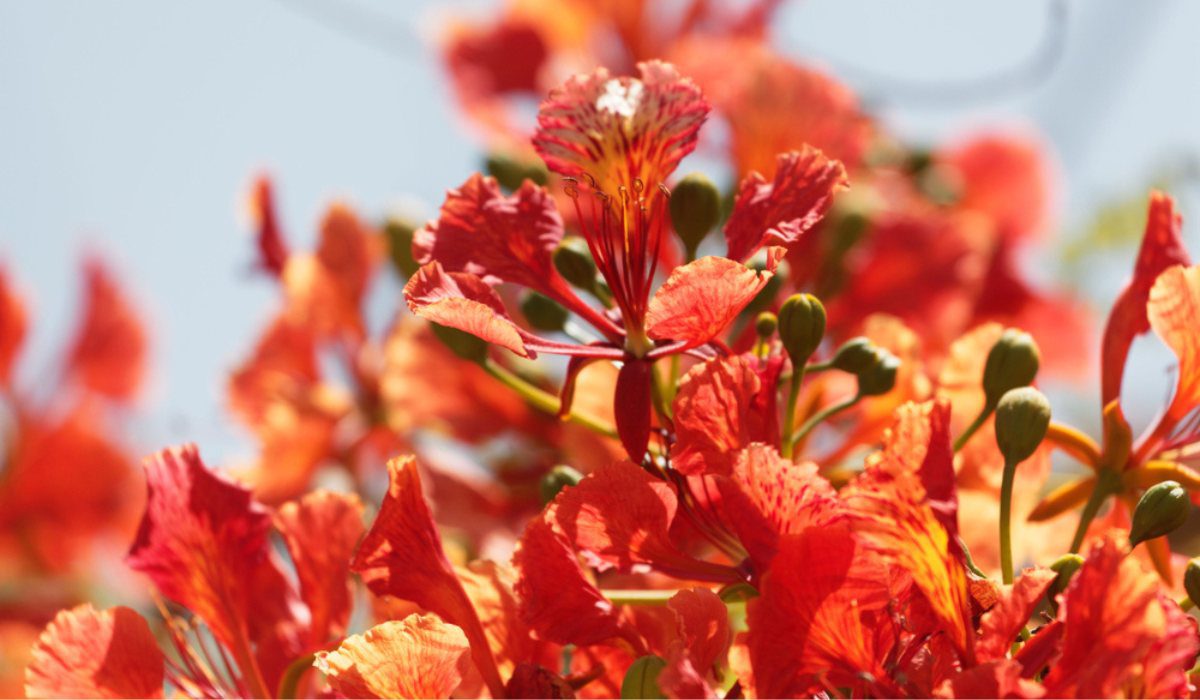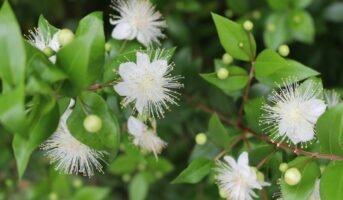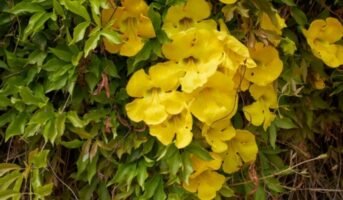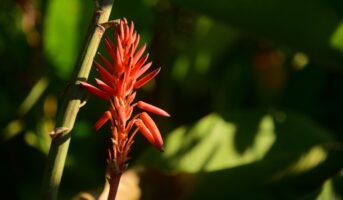Delonix regia, also known as flamboyant or royal poinciana, is a tropical tree native to Madagascar that has been widely planted in tropical and semi-tropical areas around the world. It can reach a height of 30-40 feet and has a broad-spreading, flat-topped, umbrella-like crown. Mature tree crowns can often be 60-70′ wide.
This tree is well-known for its stunning ornamental display of showy scarlet flowers and compound mimosa-like leaves. It can be grown outdoors in the far southern states of Florida, Texas, Arizona, and California, as well as Hawaii, in the United States as well as in many nations. This tree is deciduous in dry climates or mildly cool winters, but otherwise, it is evergreen.
With four spreading crimson or orange-red petals that can reach a length of 8 cm (3 in) and a fifth erect petal that is slightly larger and dotted with yellow and white, Delonix regia flowers are huge. Corymbs form along and at the ends of branches. Flavia is a naturally occurring variety with yellow flowers. When young, the pods are green and flaccid, but as they mature, they turn dark brown and woody.
See also: Mimusops Elengi: Know more about the Spanish Cherry
Delonix regia: Key facts
| Scientific name | Delonix regia |
| Family name | Fabaceae |
| Common names | Flamboyant, phoenix flower, flame of the forest, flame tree, royal poinciana |
| Height | 30-40 feet tall |
| Blooming Time | June to July |
| Uses | Delonix regia is an excellent flowering tree for gardens, parks, along streets, and large front yards where it is winter hardy. Mature trees provide plenty of shade. |
| Environmental Impact | Positive |
| Maintenance | Low |
| Best season for growth | Winters |
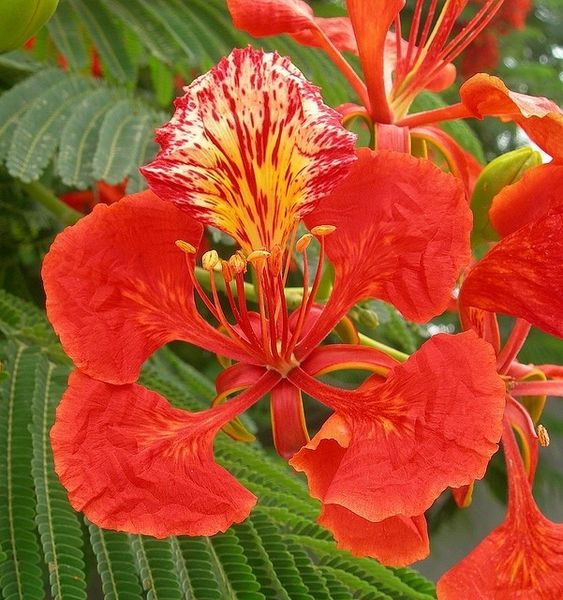
Source: Pinterest
Know more about the Spanish Cherry
Delonix regia: Physical properties
It has large scarlet flowers that stand out against the green leafy background. A rarer variety has smaller, orange flowers. In the presence of sunlight and healthy, well-drained soil, the tree grows to an average height of approximately 16 metres.
Delonix regia flowers appear in an inflorescence, with the older flowers at the base and the younger ones at the tip of the flower stalk. The flower has five sepals, each of which is green on the outside and scarlet on the inside. The Delonix regia tree’s short main trunk is separated into several sizable branches, which spread out to create a broad, umbrella-shaped crown. The bark of this flamboyant tree is smooth and silvery-grey in colour.
The flamboyant tree rarely blows over because of its deep, sturdy roots. Buttress roots are common and provide additional support to the tree. The flamboyant tree has complex, bipinnate leaves that are segmented into leaflets, or pinnae, which are then further segmented into pinnules. At the end, there are neither pinnae nor pinnules. Each pinnule is a delicate structure that measures approximately 10mm long and 4mm wide. At dusk, the leaflets fold.
Butterfly pollination is common for Delonix regia flowers. Each flower’s ovary develops into a legume or pod. The mature pod measures 30 to 60 cm in length, is slightly curved and is woody. It splits open, exposing blackish seeds.
Delonix regia: Cultivation
- It is simple to grow a Delonix regia bonsai (Flame tree).
- There are two ways to obtain a healthy bonsai tree: seeds and cuttings.
- Seed propagation is a common practice. To collect seeds, soak healthy seeds in stable warm water at 68 degrees Fahrenheit/20 degrees Celsius for at least 24 hours.
- By cutting through the epidermis of the seeds with a knife, the soaking time can be reduced.
- After that, plant the seeds in warm, moist soil, where they will germinate in about 2-3 weeks.
- Cutting propagation is less common, but it is also possible.
- Delonix regia branches are cut into 30 cm (12 in.) pieces and planted in the same warm, moist soil mixture.
- It should grow new roots and mature into a small tree in a few months.
- Make certain that the Delonix regia pot you choose has adequate drainage.
- Warm water should be applied evenly to the pot until the excess water drains smoothly from the hole.
- The soil should also be water-retentive.
- Sand, organic compost, and moss can be used to make the soil.
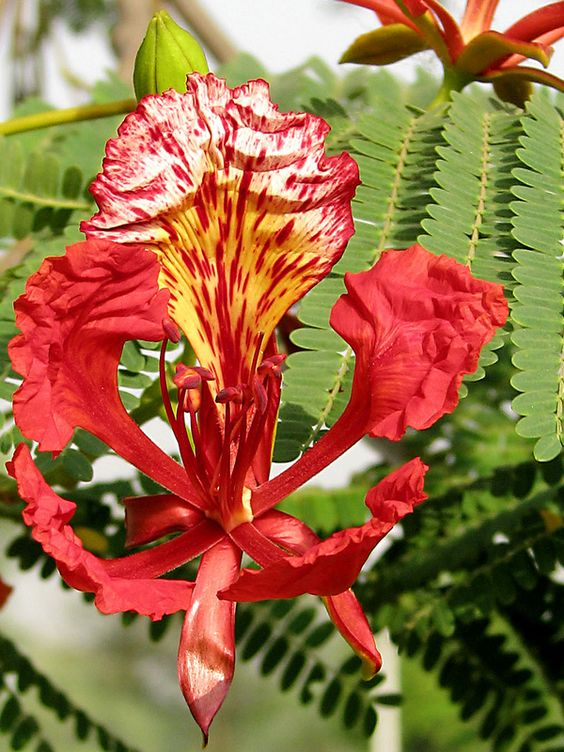
Source: Pinterest
Delonix regia: Maintenance
Temperature
This plant is native to the tropics. It is affected by temperature changes. It is evergreen in hot, dry conditions but deciduous in cooler temperatures. It grows best at temperatures ranging from 50° F (10° C) to 68° F (20° C). As a result, it is advised to place it in a sunny indoor or greenhouse environment. In the fall and winter, you should take insulation measures to keep it above 50 degrees Fahrenheit / 10 degrees Celsius. When your room is too cold, grow tents, and LED grow lights are a good solution. Installing a thermometer near the tree allows you to easily check the temperature and thus avoid low temperatures.
Water
It is a general rule for Delonix to keep the soil moist at all times. When the weather is warm and sunny, it grows quickly. Young trees require a lot of water to grow, especially in their first summer, but don’t overwater as this can damage the tree’s roots. If it loses a lot of leaves when the temperature drops, it does not require frequent watering. Delonix regia can withstand light drought. Mature trees require very little additional irrigation.
Fertilisation
Delonix regia requires a lot of nutrients during the first two years of seedling growth to support growth and flowering. You can use organic fertiliser or a general-purpose liquid plant fertiliser. Apply an organic fertiliser every four weeks or a fertiliser with a balanced N-P-K ratio every week to promote healthy growth and flowering. However, take care not to overdo it.
Pruning
Delonix regia can withstand aggressive pruning. The pruning and shaping of bonsai can begin in the second year of growth. You should actually prune it more frequently. If you let it grow, it will soon become a jumbo. Follow bonsai pruning principles in the spring and summer to reduce excess internal branching, which increases sunlight exposure and reduces nutrient depletion. For shaping, use copper or aluminium bonsai wire. After flowering has finished in late summer, carefully remove damaged wood and excess shoots. Keep an eye on the bonsai wire, and don’t let it go too long because it can damage the epidermis of Delonix regia. Premium bonsai tools make it simple to prune and repot Delonix regia / Flame trees.
Repoting instructions
If everything is in order, repot Delonix regia in early spring every year or two, depending on the size of the pot. Delonix regia’s root system will quickly take over the entire pot space due to its rapid growth. When its roots run out of room to grow, the entire bonsai tree will stop growing and eventually die. Remove Delonix regia from the pot with care, removing about one-third of the roots, and paying special attention to the dead roots and the strong roots at the bottom. Repot it in the pot, cover it with new soil, water it lightly to ensure the pot drains properly, and watch it grow.
Pests
Delonix regia’s enemy is scale, which can appear in the winter. When you find them on a bonsai tree, remove them with tweezers. If they keep appearing, you can kill them with a special insecticide. Other pests that may appear on your tree include borers and caterpillars. Monitor the growth of your trees on a regular basis to ensure that they are growing in a healthy environment.
Delonix regia: Uses
Medicinal
- The Delonix regia tree is endowed with numerous medicinal properties. It has antibacterial, anti-inflammatory, antifungal, antimicrobial, antioxidant, antimalarial, gastroprotective, and cardioprotective properties, as well as wound healing properties.
- The leaves of the Delonix regia tree are anti-diabetic. The methanol extract of these leaves is used to lower blood glucose levels.
- The leaves of the Delonix regia tree may have hepatoprotective properties.
- The plants’ leaves have antidiarrheal properties.
- It contains flavonoids, which help to protect the liver’s health.
- Antifungal properties of essential oil extracted from Delonix regia tree leaves
- The plant is used to treat a variety of physical conditions in ancient and folk medicine, including constipation, rheumatoid arthritis, inflammation, diabetes, malaria, and pneumonia.
- This plant is used to rehabilitate the soil.
- It can also aid in the fixation of atmospheric nitrogen.
See also: What are the medicinal benefits of Camellia Japonica aka Japanese Camellia?
Commercial
- The Delonix regia plant’s wood is used as fuel. This wood has a calorific value of 4600 kcal/kg.
- Delonix regia flowers are used to feed bees in bee farming.
- This plant produces thick, water-soluble gum. This natural gum is used as a binding agent in the furniture and textile industries.
- We get pangam oil from the seeds, which is very useful in the tanning industry.
- The Delonix regia plant’s hard and elongated seeds are frequently used as beads in jewellery.
FAQs:
What is the negative environmental impact of growing Delonix regia?
Delonix regia is also an aggressive coloniser, occupying blank areas to the exclusion of other species, and it has the ability to form dense canopies that prevent native species from thriving. As a result of its spreading root system, other plants are killed by competition, leaving the surrounding ground bare.
Are there any disadvantages of growing Delonix regia?
The only disadvantage of this plant is that it takes up a lot of space in the garden. The crown spread of this tree is extremely difficult to control. Furthermore, because of its shallow roots, this plant is vulnerable to strong winds and storms.
Is Delonix regia poisonous?
Yes, Delonix regia is poisonous. Although the roots, seeds, and leaves of the plant are used to treat diseases and ailments, the seeds are poisonous due to their antinutrient content, especially when mature.
Housing News Desk is the news desk of leading online real estate portal, Housing.com. Housing News Desk focuses on a variety of topics such as real estate laws, taxes, current news, property trends, home loans, rentals, décor, green homes, home improvement, etc. The main objective of the news desk, is to cover the real estate sector from the perspective of providing information that is useful to the end-user.
Facebook: https://www.facebook.com/housing.com/
Twitter: https://twitter.com/Housing
Email: [email protected]
